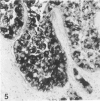Abstract
The correct distinction between malignant mesothelioma of the pleura and adenocarcinoma of the lung has become increasingly complex, with a variety of histochemical, immunohistochemical, and ultrastructural studies to be performed on biopsy material. The reliability of immunohistochemical studies has been hampered by the use of polyclonal antisera to "carcinoembryonic antigen (CEA)" and keratin. Hybridoma technology now offers monoclonal antibodies (MAbs) in unlimited quantity and standardized quality to selective ranges of specific antigenic determinants. MAb B72.3, generated against a membrane-enriched fraction of human metastatic breast carcinoma, was used to distinguish malignant mesothelioma of the pleura from adenocarcinoma of the lung in tissue sections and was compared in terms of diagnostic utility with polyclonal anti-keratin and anti-CEA to make the same distinction. Reactivity with MAb B72.3 in at least 10% of tumor cells or more was noted in 19 of 22 adenocarcinomas of the lung (P greater than 0.0001), whereas none of the 20 cases of malignant mesothelioma demonstrated comparable reactivity. Furthermore, MAb B72.3 showed no reactivity with benign mesothelial proliferations. MAb B72.3 thus appears to be an appropriate diagnostic adjunct capable of discriminating between these malignancies.
Full text
PDF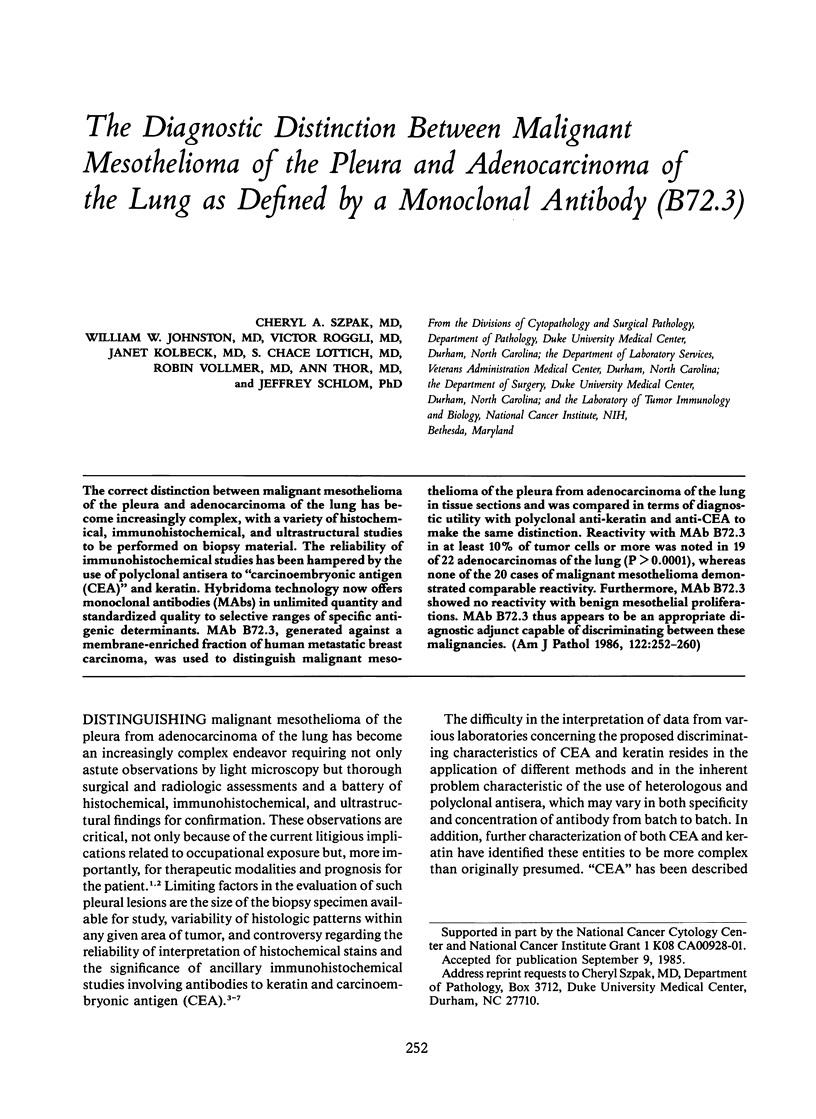



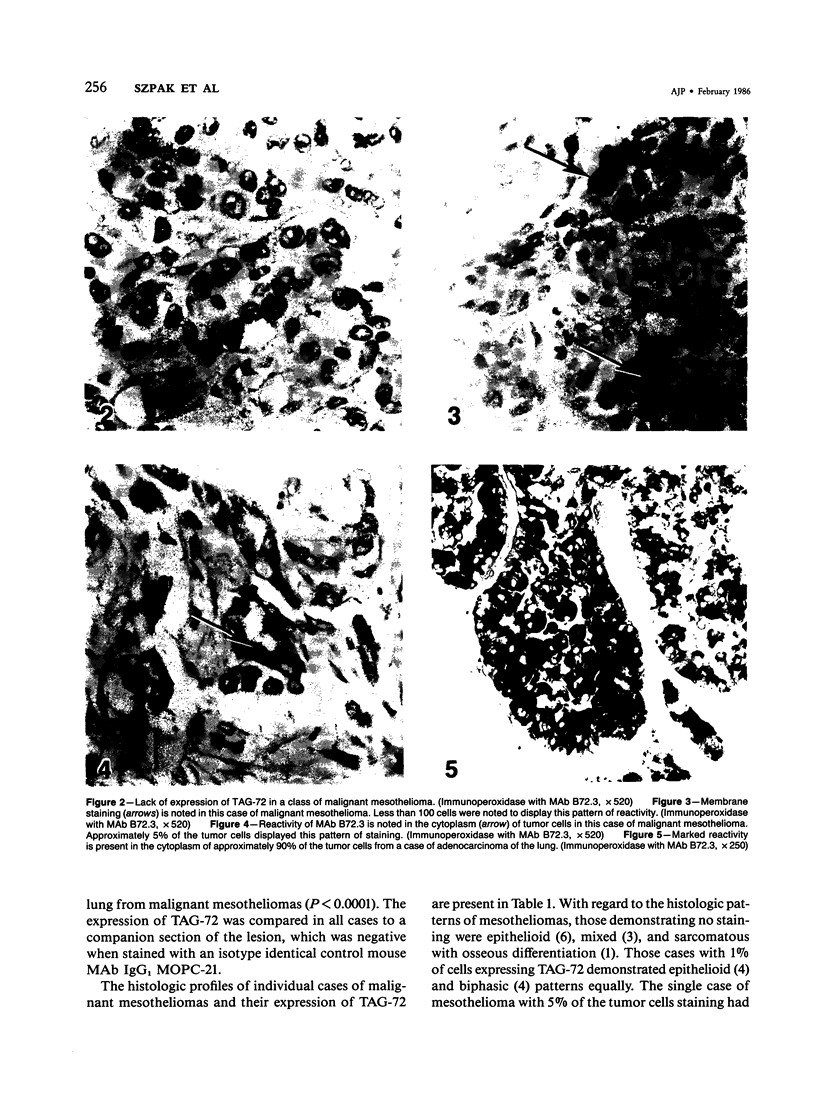
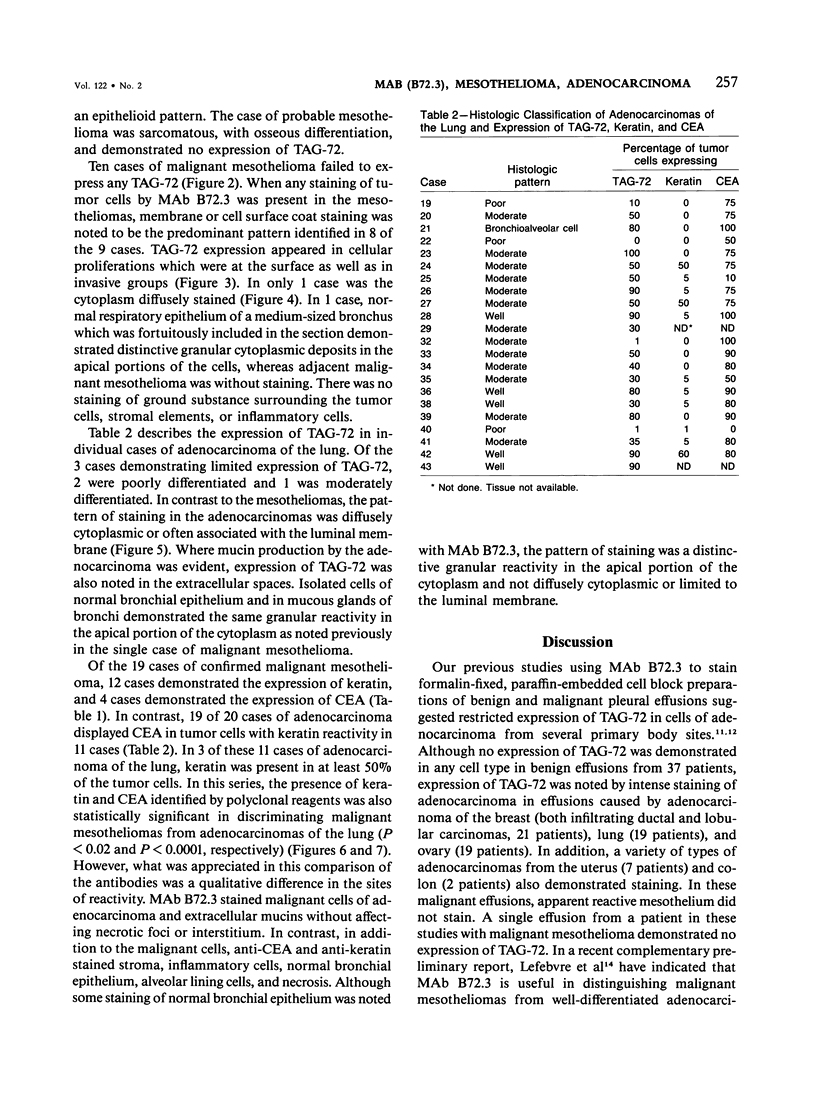

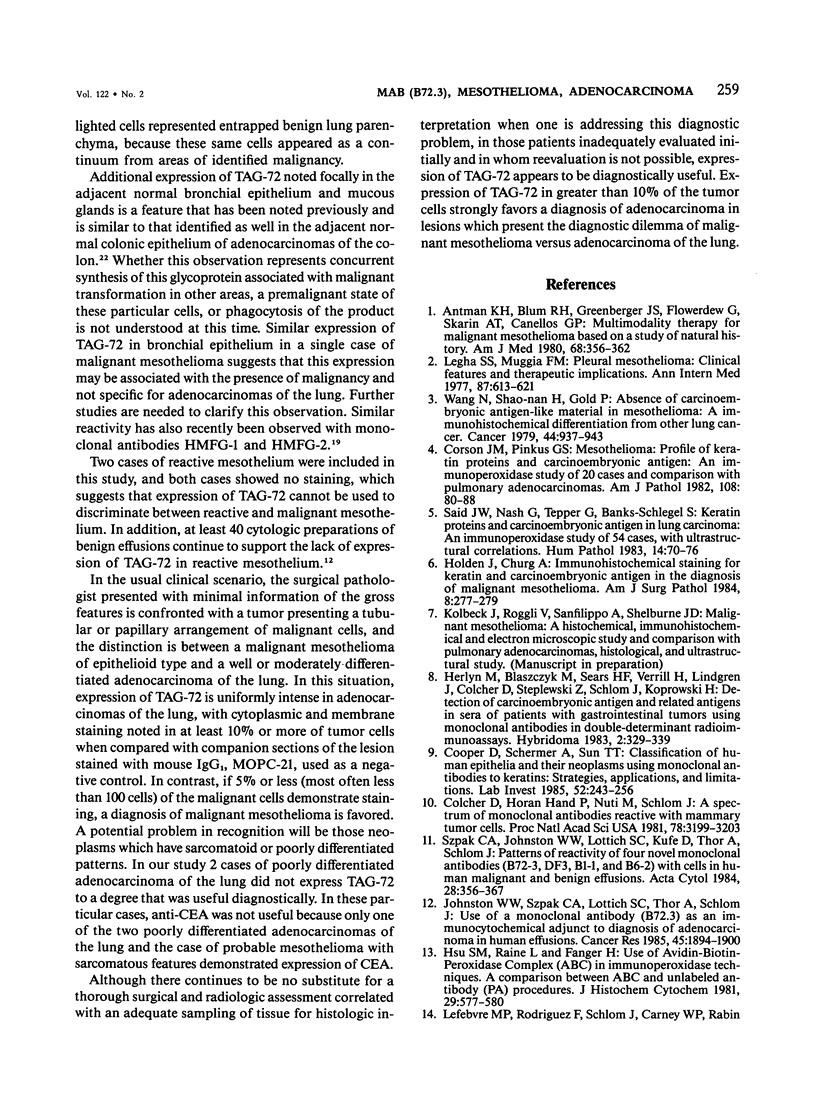

Images in this article
Selected References
These references are in PubMed. This may not be the complete list of references from this article.
- Antman K. H., Blum R. H., Greenberger J. S., Flowerdew G., Skarin A. T., Canellos G. P. Multimodality therapy for malignant mesothelioma based on a study of natural history. Am J Med. 1980 Mar;68(3):356–362. doi: 10.1016/0002-9343(80)90103-5. [DOI] [PubMed] [Google Scholar]
- Battifora H., Kopinski M. I. Distinction of mesothelioma from adenocarcinoma. An immunohistochemical approach. Cancer. 1985 Apr 15;55(8):1679–1685. doi: 10.1002/1097-0142(19850415)55:8<1679::aid-cncr2820550812>3.0.co;2-c. [DOI] [PubMed] [Google Scholar]
- Colcher D., Hand P. H., Nuti M., Schlom J. A spectrum of monoclonal antibodies reactive with human mammary tumor cells. Proc Natl Acad Sci U S A. 1981 May;78(5):3199–3203. doi: 10.1073/pnas.78.5.3199. [DOI] [PMC free article] [PubMed] [Google Scholar]
- Cooper D., Schermer A., Sun T. T. Classification of human epithelia and their neoplasms using monoclonal antibodies to keratins: strategies, applications, and limitations. Lab Invest. 1985 Mar;52(3):243–256. [PubMed] [Google Scholar]
- Corson J. M., Pinkus G. S. Mesothelioma: profile of keratin proteins and carcinoembryonic antigen: an immunoperoxidase study of 20 cases and comparison with pulmonary adenocarcinomas. Am J Pathol. 1982 Jul;108(1):80–88. [PMC free article] [PubMed] [Google Scholar]
- Ghosh A. K., Mason D. Y., Spriggs A. I. Immunocytochemical staining with monoclonal antibodies in cytologically "negative" serous effusions from patients with malignant disease. J Clin Pathol. 1983 Oct;36(10):1150–1153. doi: 10.1136/jcp.36.10.1150. [DOI] [PMC free article] [PubMed] [Google Scholar]
- Ghosh A. K., Spriggs A. I., Taylor-Papadimitriou J., Mason D. Y. Immunocytochemical staining of cells in pleural and peritoneal effusions with a panel of monoclonal antibodies. J Clin Pathol. 1983 Oct;36(10):1154–1164. doi: 10.1136/jcp.36.10.1154. [DOI] [PMC free article] [PubMed] [Google Scholar]
- Herlyn M., Blaszczyk M., Sears H. F., Verrill H., Lindgren J., Colcher D., Steplewski Z., Schlom J., Koprowski H. Detection of carcinoembryonic antigen and related antigens in sera of patients with gastrointestinal tumors using monoclonal antibodies in double-determinant radioimmunoassays. Hybridoma. 1983;2(3):329–339. doi: 10.1089/hyb.1983.2.329. [DOI] [PubMed] [Google Scholar]
- Holden J., Churg A. Immunohistochemical staining for keratin and carcinoembryonic antigen in the diagnosis of malignant mesothelioma. Am J Surg Pathol. 1984 Apr;8(4):277–279. doi: 10.1097/00000478-198404000-00004. [DOI] [PubMed] [Google Scholar]
- Hsu S. M., Raine L., Fanger H. Use of avidin-biotin-peroxidase complex (ABC) in immunoperoxidase techniques: a comparison between ABC and unlabeled antibody (PAP) procedures. J Histochem Cytochem. 1981 Apr;29(4):577–580. doi: 10.1177/29.4.6166661. [DOI] [PubMed] [Google Scholar]
- Johnston W. W., Szpak C. A., Lottich S. C., Thor A., Schlom J. Use of a monoclonal antibody (B72.3) as an immunocytochemical adjunct to diagnosis of adenocarcinoma in human effusions. Cancer Res. 1985 Apr;45(4):1894–1900. [PubMed] [Google Scholar]
- Legha S. S., Muggia F. M. Pleural mesothelioma: clinical features and therapeutic implications. Ann Intern Med. 1977 Nov;87(5):613–621. doi: 10.7326/0003-4819-87-5-613. [DOI] [PubMed] [Google Scholar]
- Marshall R. J., Herbert A., Braye S. G., Jones D. B. Use of antibodies to carcinoembryonic antigen and human milk fat globule to distinguish carcinoma, mesothelioma, and reactive mesothelium. J Clin Pathol. 1984 Nov;37(11):1215–1221. doi: 10.1136/jcp.37.11.1215. [DOI] [PMC free article] [PubMed] [Google Scholar]
- Said J. W., Nash G., Tepper G., Banks-Schlegel S. Keratin proteins and carcinoembryonic antigen in lung carcinoma: an immunoperoxidase study of fifty-four cases, with ultrastructural correlations. Hum Pathol. 1983 Jan;14(1):70–76. doi: 10.1016/s0046-8177(83)80048-3. [DOI] [PubMed] [Google Scholar]
- Szpak C. A., Johnston W. W., Lottich S. C., Kufe D., Thor A., Schlom J. Patterns of reactivity of four novel monoclonal antibodies (B72.3, DF3, B1.1 and B6.2) with cells in human malignant and benign effusions. Acta Cytol. 1984 Jul-Aug;28(4):356–367. [PubMed] [Google Scholar]
- To A., Coleman D. V., Dearnaley D. P., Ormerod M. G., Steele K., Neville A. M. Use of antisera to epithelial membrane antigen for the cytodiagnosis of malignancy in serous effusions. J Clin Pathol. 1981 Dec;34(12):1326–1332. doi: 10.1136/jcp.34.12.1326. [DOI] [PMC free article] [PubMed] [Google Scholar]
- Wanebo H. J., Martini N., Melamed M. R., Hilaris B., Beattie E. J., Jr Pleural mesothelioma. Cancer. 1976 Dec;38(6):2481–2488. doi: 10.1002/1097-0142(197612)38:6<2481::aid-cncr2820380637>3.0.co;2-9. [DOI] [PubMed] [Google Scholar]
- Wang N. S., Huang S. N., Gold P. Absence of carcinoembryonic antigen-like material in mesothelioma: an immunohistochemical differentiation from other lung cancers. Cancer. 1979 Sep;44(3):937–943. doi: 10.1002/1097-0142(197909)44:3<937::aid-cncr2820440322>3.0.co;2-k. [DOI] [PubMed] [Google Scholar]
- Woods J. C., Spriggs A. I., Harris H., McGee J. O. A new marker for human cancer cells. 3. Immunocytochemical detection of malignant cells in serous fluids with the Ca1 antibody. Lancet. 1982 Sep 4;2(8297):512–514. doi: 10.1016/s0140-6736(82)90598-0. [DOI] [PubMed] [Google Scholar]






